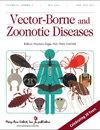First Isolation of Japanese Encephalitis Virus Genotype IV from Mosquitoes in Australia.
IF 1.8
4区 医学
Q3 INFECTIOUS DISEASES
引用次数: 0
Abstract
Introduction: Widespread transmission of Japanese encephalitis virus (JEV) genotype four (GIV) occurred across mainland Australia in 2022. This resulted in forty-five human cases, including seven deaths, and the identification of JEV infection in over 80 commercial piggeries. Materials and Methods: We collected mosquitoes which were trapped using CO2-baited light traps deployed near piggeries reporting disease or in regions linked to human cases in the Wide Bay region in the state of Queensland. Mosquitoes from four traps yielded JEV RNA by real-time RT-PCR. Pools containing RNA positive mosquitoes were inoculated onto mosquito cell monolayers. Discussion: A single isolate of JEV was obtained from a pool of mixed mosquito species. Near whole genome sequencing and phylogenetic analysis of the JEV isolate demonstrated its high genomic relatedness with JEV GIV pig sequences sampled from Queensland and the state of New South Wales in 2022. Conclusion: We report the first isolation of JEV GIV from mosquitoes collected in Australia. With only a few JEV GIV isolates available globally, the isolate we report will be essential for future research of JEV host interactions, evolution and disease markers, and development of effective therapies, vaccines, diagnostic assays, and mosquito control strategies.澳大利亚首次从蚊子中分离出日本脑炎病毒基因 IV 型。
导言:2022 年,日本脑炎病毒(JEV)基因型四(GIV)在澳大利亚大陆广泛传播。这导致了 45 例人类病例,其中 7 例死亡,并在 80 多个商业猪舍中发现了 JEV 感染。材料与方法:我们在昆士兰州宽湾地区报告疾病的猪舍附近或与人类病例有关的地区使用二氧化碳诱饵灯诱捕器收集蚊子。通过实时 RT-PCR 检测,四个诱捕器中的蚊子都产生了 JEV RNA。将含有 RNA 阳性蚊子的蚊子池接种到蚊子细胞单层上。讨论结果从混合蚊子物种池中获得了单一的 JEV 分离物。对该 JEV 分离物的近全基因组测序和系统发育分析表明,它与 2022 年在昆士兰州和新南威尔士州采样的 JEV GIV 猪序列具有很高的基因组亲缘关系。结论:我们报告了首次从澳大利亚采集的蚊子中分离出的 JEV GIV。由于全球仅有少量 JEV GIV 分离物,我们报告的分离物对未来研究 JEV 宿主相互作用、进化和疾病标记物,以及开发有效疗法、疫苗、诊断检测和蚊虫控制策略至关重要。
本文章由计算机程序翻译,如有差异,请以英文原文为准。
求助全文
约1分钟内获得全文
求助全文
来源期刊
CiteScore
4.70
自引率
4.80%
发文量
73
审稿时长
3-8 weeks
期刊介绍:
Vector-Borne and Zoonotic Diseases is an authoritative, peer-reviewed journal providing basic and applied research on diseases transmitted to humans by invertebrate vectors or non-human vertebrates. The Journal examines geographic, seasonal, and other risk factors that influence the transmission, diagnosis, management, and prevention of this group of infectious diseases, and identifies global trends that have the potential to result in major epidemics.
Vector-Borne and Zoonotic Diseases coverage includes:
-Ecology
-Entomology
-Epidemiology
-Infectious diseases
-Microbiology
-Parasitology
-Pathology
-Public health
-Tropical medicine
-Wildlife biology
-Bacterial, rickettsial, viral, and parasitic zoonoses

 求助内容:
求助内容: 应助结果提醒方式:
应助结果提醒方式:


